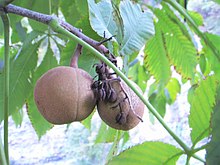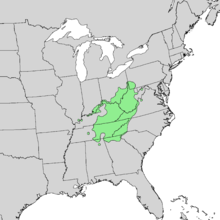Yellow buckeye
|
Aesculus flava Yellow buckeye |
|
|---|---|
 |
|
| Fruit and leaves of Aesculus octandra | |
| Scientific classification | |
| Kingdom: | Plantae |
| Clade: | Angiosperms |
| Clade: | Eudicots |
| Clade: | Rosids |
| Order: | Sapindales |
| Family: | Sapindaceae |
| Genus: | Aesculus |
| Species: | A. flava |
| Binomial name | |
|
Aesculus flava Sol. |
|
 |
|
| Synonyms | |
|
Aesculus octandra |
|
Aesculus octandra
Aesculus flava, the yellow buckeye, common buckeye, sweet buckeye, or colloquially as "sweet chestnut" in the United Kingdom, to some confusion is a species of deciduous tree. It is native to the Ohio Valley and Appalachian Mountains of the Eastern United States. It grows in mesophytic forest or floodplains, generally in acid to circumneutral soil, reaching a height of 20m to 47m.
The leaves are palmately compound with five (rarely seven) leaflets, 10–25 cm long and broad. The flowers are produced in panicles in spring, yellow to yellow-green, each flower 2–3 cm long with the stamens shorter than the petals (unlike the related A. glabra (Ohio buckeye), where the stamens are longer than the petals). The twigs have a faintly rank odor, but much less so than the Ohio buckeye, A. glabra. The fruit is a smooth (spineless), round or oblong capsule 5–7 cm diameter, containing 1-3 nut-like seeds, 2.5-3.5 cm diameter, brown with a whitish basal scar. The fruit is poisonous to humans but can be made edible through a leaching process.
Aesculus flava is cultivated as an ornamental tree. The tree's showy yellow flowers and good autumn color are attractive in larger gardens and in parks.
This plant has gained the Royal Horticultural Society's Award of Garden Merit.
Leaf
Bark
Spring bud break
Fruit
...
Wikipedia
